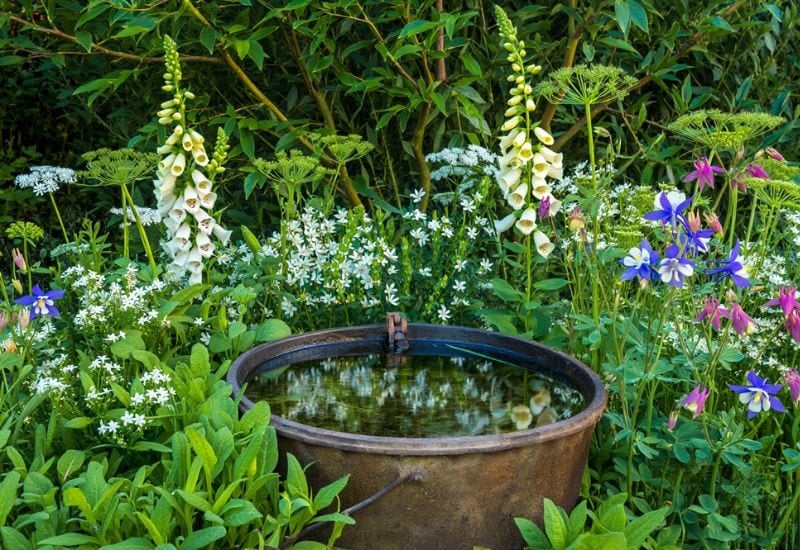
If you’ve ever lost a favorite plant to slugs, you know that sinking feeling. One day everything looks perfect, and the next morning your hostas are lace and your new seedlings are gone without a trace. Shade gardens, with their cool, damp soil, are heaven for slugs and snails—but not every plant on their menu is so easy to chew.
Over the years, I’ve learned there are certain perennials that slugs just won’t touch. Some have leaves too tough or hairy, others taste too bitter, and a few seem to have their own quiet chemical armor. Whatever the reason, these plants stay neat and untouched while the rest of the garden gets shredded. And the best part? They’re not just survivors—they’re beautiful.
From early spring bloomers like hellebores and lungwort to late-season showstoppers like Japanese anemones and foxgloves, these shade lovers don’t just tolerate low light—they thrive in it. They bring flowers, color, and structure to those tricky, dim corners without a single bite mark in sight.
So if you’re ready to stop sprinkling slug pellets and start growing plants that can take care of themselves, here are 15 tried-and-true perennials that prove a shady garden can be lush, colorful, and completely hole-free.
1: Fairy Wings (Epimedium spp.)
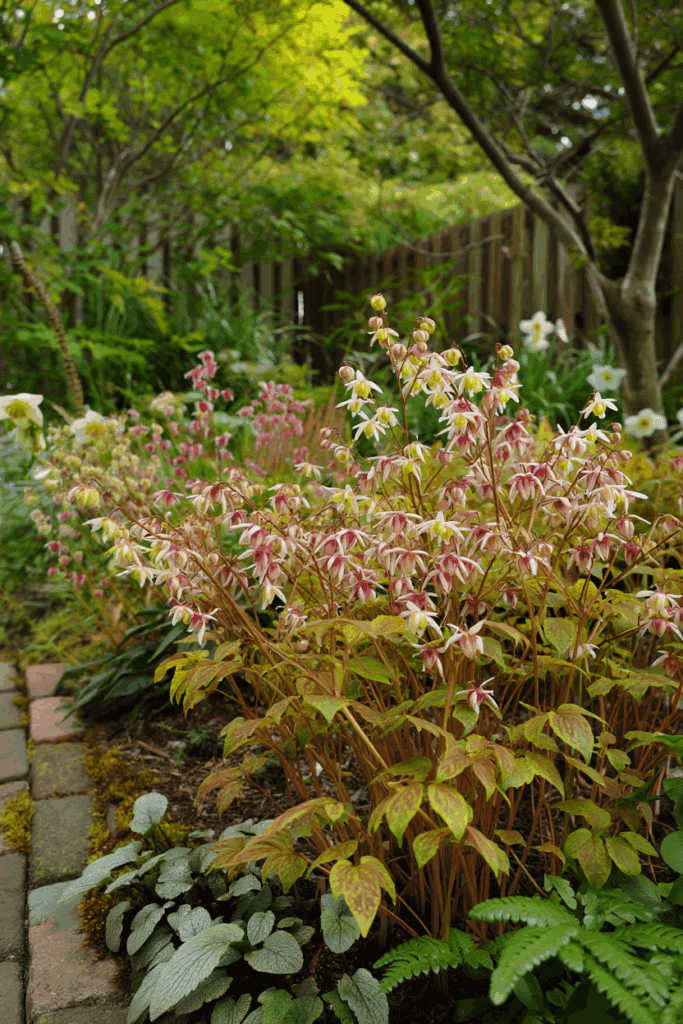
If slugs and snails have turned your shade garden into a buffet, Fairy Wings might be the plant that finally ends the midnight raids. Its foliage is rich in bitter alkaloids and saponins—natural chemical defenses that make the leaves taste terrible to molluscs. On top of that, the thick, leathery texture and waxy surface layer are nearly impossible for a slug’s rasping mouthparts to penetrate. The result: foliage that stays flawless even in damp, shaded corners where other plants get devoured overnight.
In the garden, Fairy Wings form graceful mounds of heart-shaped leaves that emerge bronze or mottled in spring before turning lush green through summer and often glowing red in fall. Airy spurred blooms in shades of white, yellow, pink, or lavender appear in early spring, hovering above the foliage like a cloud of tiny butterflies. Once established, they handle dry shade under trees, root competition, and even summer drought with ease—while remaining entirely pest-free.
- USDA Zones: 5–9 (some hardy to Zone 4)
- Light: Partial to full shade
- Soil: Moist, humus-rich, well-drained; tolerates dry shade once established
- Bloom Time: Spring (April–May)
- Height/Spread: 8–15 in. tall, 18–24 in. wide
2: Hardy Geraniums (Geranium spp.)
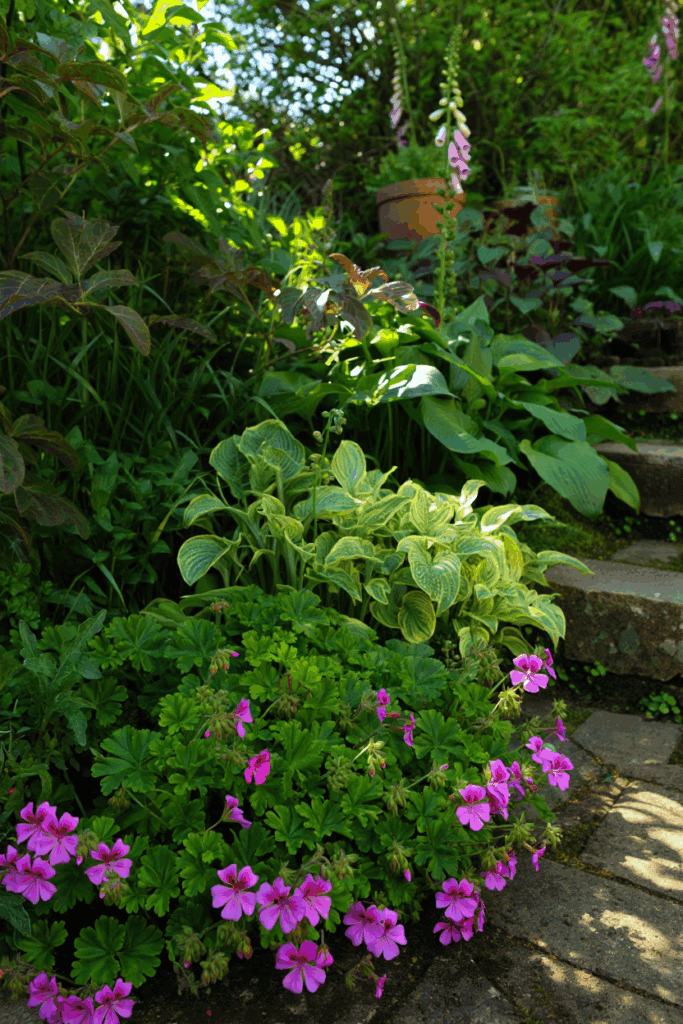
Few perennials earn their keep in a slug-prone garden like hardy geraniums. Their foliage is rich in aromatic oils and tannins that make the leaves distasteful to molluscs, and the slightly hairy, fibrous texture offers little appeal to soft-bodied pests. Even in damp conditions, slugs tend to pass them by in favor of tender plants like hostas or delphiniums. And if a few bites appear in spring, geraniums grow fast enough to outpace any damage within a week.
These are truly adaptable plants—happy in full sun or partial shade, dry soil or moisture-retentive ground, as long as drainage is good. The range is vast: ‘Rozanne’ flowers from early summer to frost in endless violet-blue waves; Geranium phaeum handles deep shade with dusky elegance; and G. sanguineum var. striatum (AGM) forms a dainty, pink-edged carpet for borders or paths. Every one brings color, movement, and reliability without ever becoming slug bait.
- USDA Zones: 4–9 (varies by species)
- Light: Full sun to partial shade
- Soil: Well-drained; tolerates both poor and moderately moist soils
- Bloom Time: Late spring through fall (depending on cultivar)
- Height/Spread: 8–24 in. tall, 12–36 in. wide
3: Foxglove (Digitalis purpurea and related species)
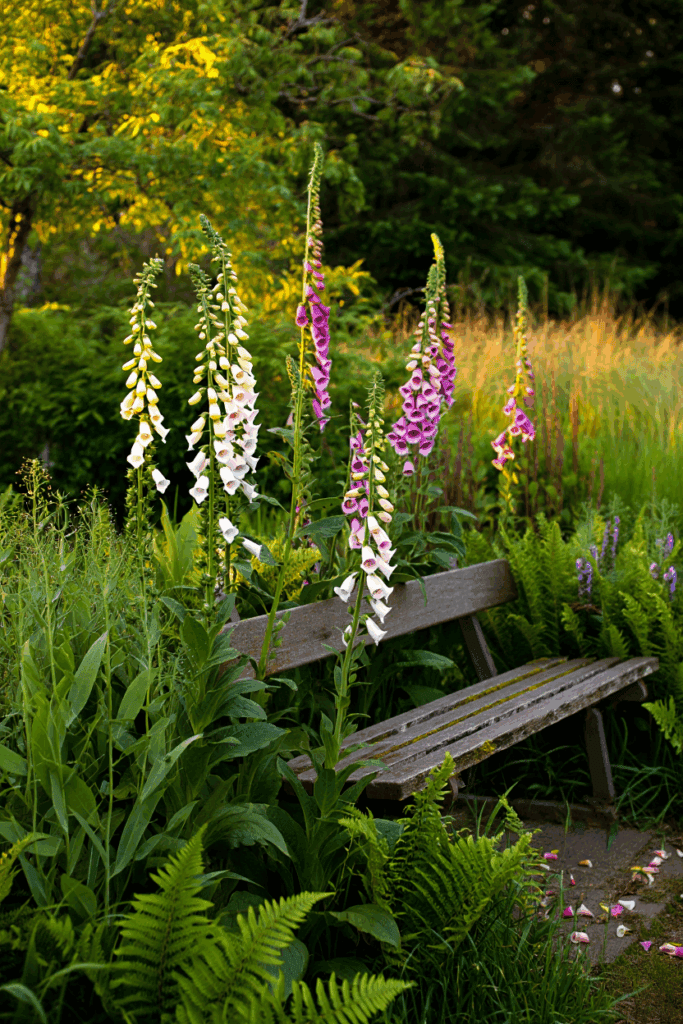
If you’ve lost too many shade plants to slugs, foxgloves will feel like a revelation. Their large, felted leaves are coated in tiny hairs called trichomes, which create a rough, unpalatable surface that slugs can’t easily rasp through. The foliage also contains bitter cardiac glycosides—natural compounds that make the leaves toxic to molluscs and most browsing pests. Even in damp, shaded beds where slugs thrive, foxgloves usually stand untouched.
These towering spires bring structure and vertical color to shady or partly sunny borders, thriving in almost any soil with decent drainage. They’re equally at home along woodland edges or tucked behind ferns and hostas, adding height and soft drama in late spring and early summer. The classic biennial Digitalis purpurea self-seeds freely—‘Sutton’s Apricot’ and ‘Pam’s Split’ are longtime favorites—but you can also choose perennial species such as D. ferruginea, D. grandiflora, or D. × mertonensis for a more permanent display. Whichever you plant, pollinators will find them irresistible, even if slugs don’t.
- USDA Zones: 4–9 (depending on species)
- Light: Full sun to partial shade
- Soil: Moist, humus-rich, well-drained
- Bloom Time: Late spring to midsummer
- Height/Spread: 2–5 ft. tall, 1–2 ft. wide
4: Lady’s Mantle (Alchemilla mollis)
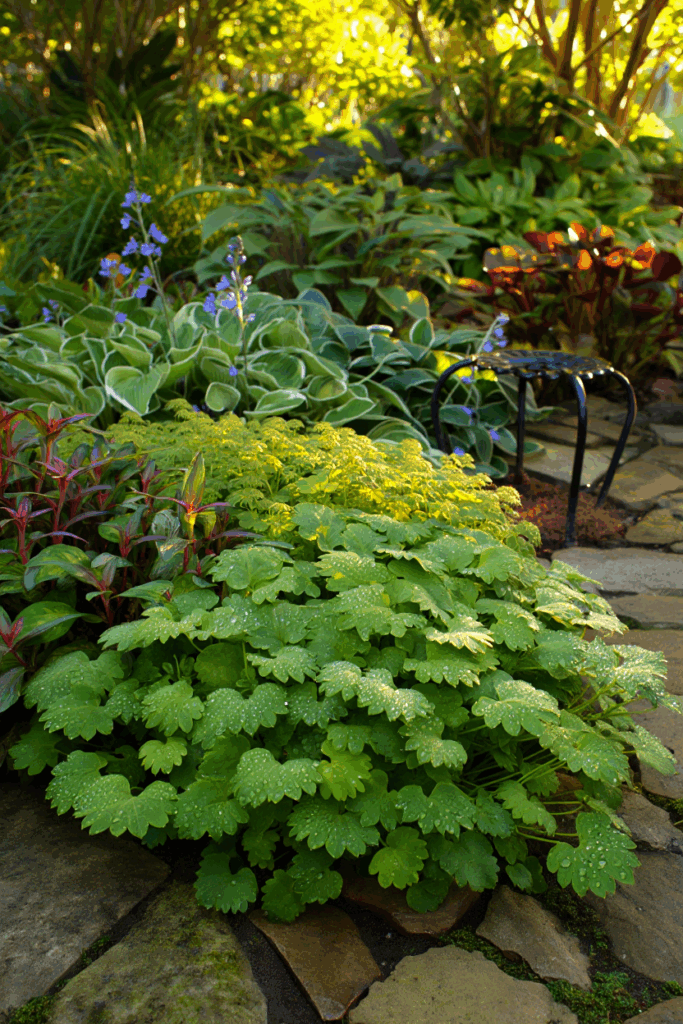
If you want a plant that slugs ignore and rain makes even prettier, Lady’s Mantle deserves a place in your garden. Its softly hairy leaves are the perfect deterrent—too fuzzy and thick for slugs to rasp through, and slightly bitter to taste. The same fine hairs that protect it from pests also catch raindrops like jewels, creating that signature look of glistening beads after a shower. You’ll often find it untouched, even when nearby hostas or delphiniums are full of holes.
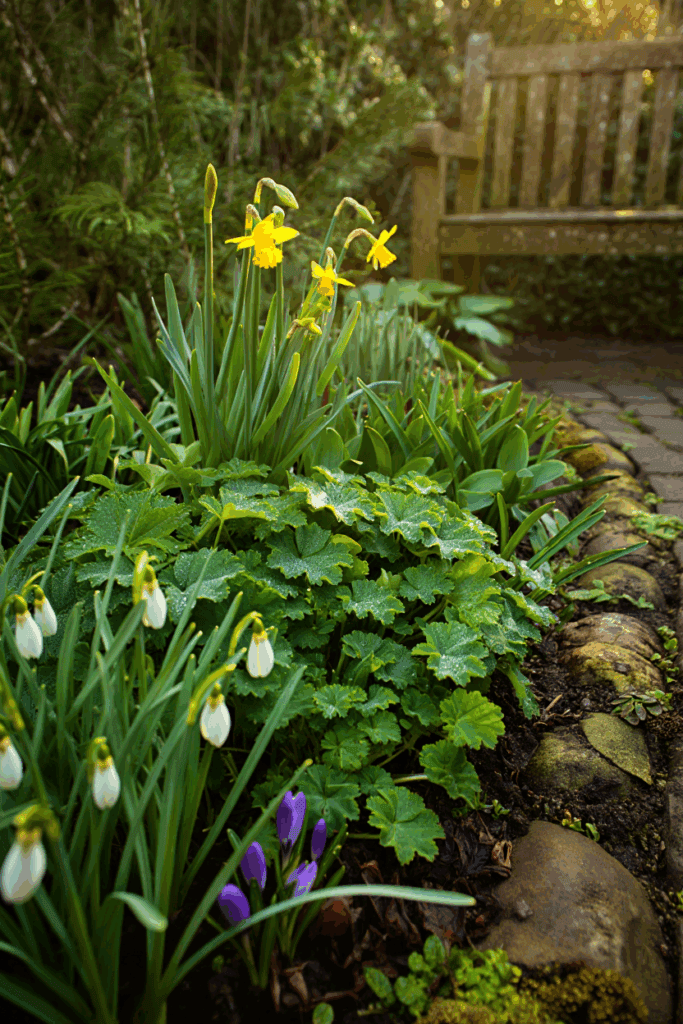
This is one of those plants that earns its keep quietly. The scalloped, apple-green leaves form a lush mound that looks fresh all season, and in early summer, airy sprays of lime-green flowers rise above the foliage like a soft mist. It’s a brilliant filler plant—tucking around paths, under roses, or between perennials—and it weaves everything together with a natural, cottage-garden ease.
Alchemilla mollis grows almost anywhere: sun or part shade, rich soil or poor, even dry spots once established. It’s drought-tolerant, long-lived, and, yes, a bit of a self-seeder—but the seedlings pull out easily, so you can keep as many or as few as you like.
- USDA Zones: 3–8
- Light: Full sun to partial shade
- Soil: Moist but well-drained; tolerates a wide range of conditions
- Bloom Time: Early to mid-summer
- Height/Spread: 12–18 in. tall, 18–24 in. wide
5: Coral Bells (Heuchera spp.)
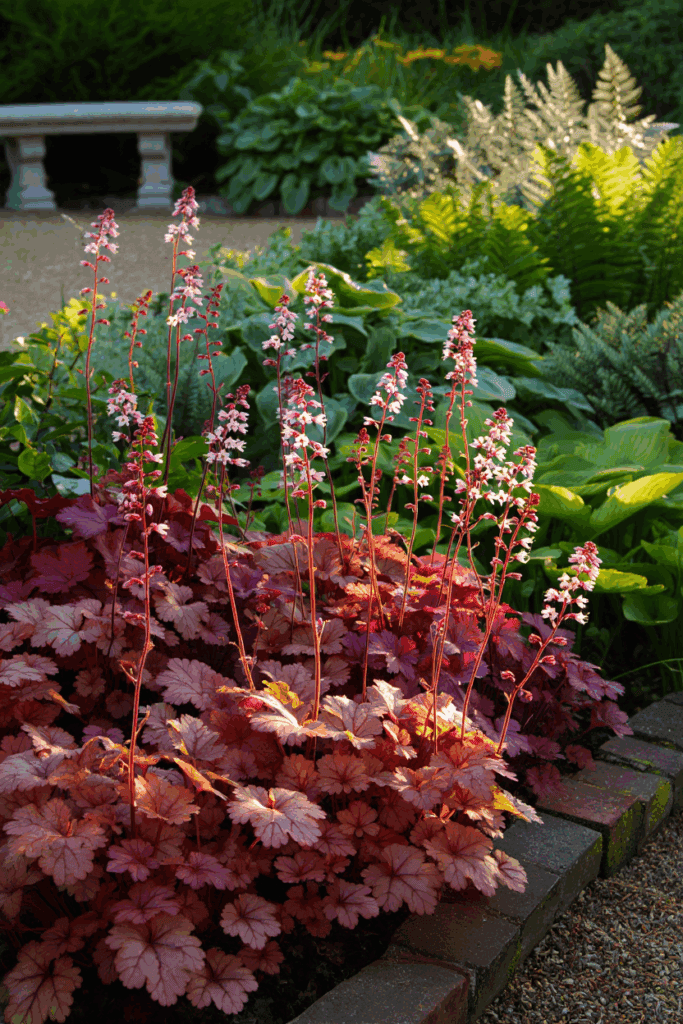
If you’ve ever woken up to find your hostas full of holes, you’ll understand why I love coral bells. Slugs just don’t seem interested in them. The leaves are tough and slightly bitter, not the soft salad-type foliage slugs crave, and that alone makes Heuchera a small miracle in a damp, shady garden. I’ve tried them in every kind of spot—under trees, along borders, even in pots by the porch—and they never disappoint.
What really sells them, though, is the color. While most shade plants stick to green, coral bells come in copper, lime, silver, plum, and everything in between. ‘Marmalade’ glows like autumn leaves, ‘Lime Marmalade’ lights up dark corners, and the old favorite ‘Palace Purple’ pairs beautifully with ferns or hostas. In late spring, they send up slender stems topped with tiny bell-shaped flowers that sway in the breeze—subtle, but charming. Give them decent drainage, and they’ll come back year after year, looking tidy and untouched while other plants turn into slug buffets.
- USDA Zones: 4–9
- Light: Partial sun to full shade
- Soil: Moist but well-drained
- Bloom Time: Late spring to summer
- Height/Spread: 8–18 in. tall, 12–24 in. wide
6: Columbine (Aquilegia spp.)
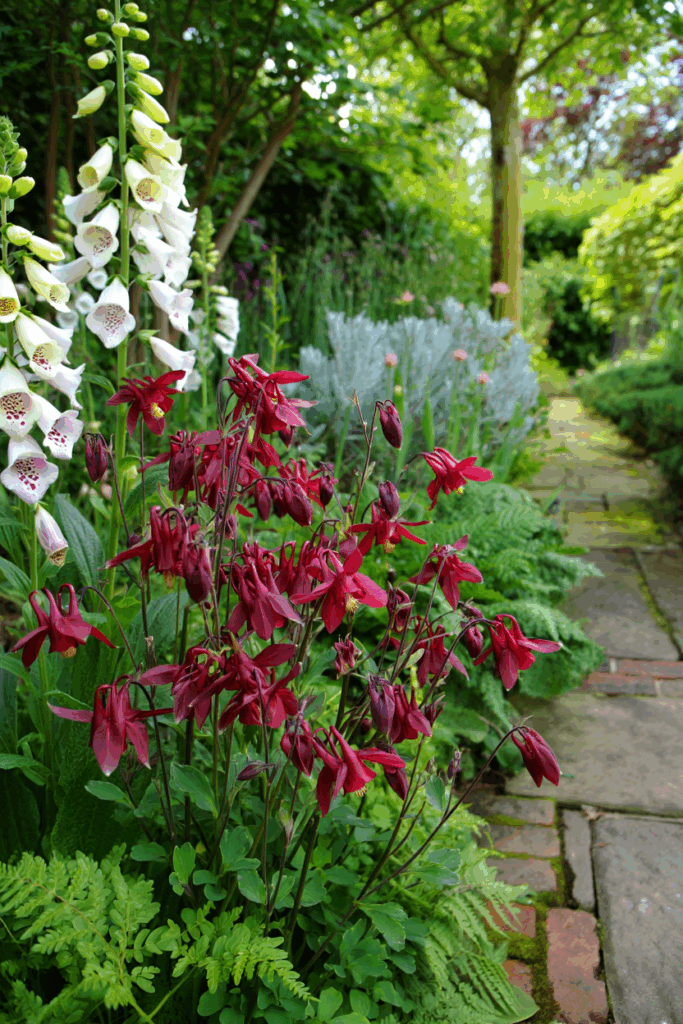
Columbines are one of those rare plants that look fragile but hold their own in a slug-heavy garden. The foliage is soft and lacy, yet slugs seem to find it completely unappetizing—most likely because it contains bitter alkaloids that make the leaves taste off. Whatever the reason, they’ll leave your columbines untouched, even in the kind of damp shade where molluscs thrive.
In late spring, tall stems rise with elegant, nodding flowers that hover like little bonnets above the foliage. They come in every shade imaginable—plum, pink, cream, yellow, even deep near-black—and mix beautifully through cottage borders, woodland edges, or gravelly paths. Columbines are short-lived but generous; they scatter seed gently, popping up the following year in new and often surprising color combinations.
If you like romantic, double blooms, try ‘Nora Barlow’, with her layered pink-and-green petals, or the dramatic ‘Black Barlow’ for a moody edge. ‘William Guinness’ is a timeless two-tone favorite, and ‘Yellow Queen’ brings a soft, luminous glow to shaded spots. For something more natural, North American Aquilegia canadensis adds cheerful red-and-yellow spurs that hummingbirds can’t resist.
- USDA Zones: 3–9
- Light: Full sun to partial shade
- Soil: Moist, well-drained; avoid very dry soil
- Bloom Time: Late spring to early summer
- Height/Spread: 18–30 in. tall, 12–18 in. wide
7: Spurge (Euphorbia spp.)
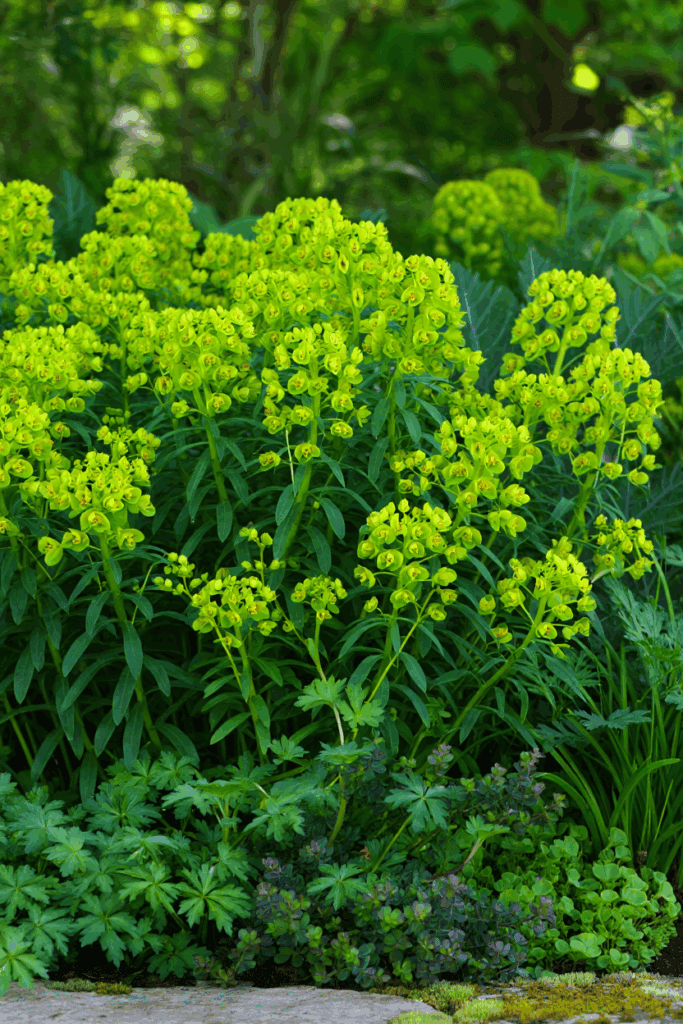
Some plants look too bold to bother with pests—and spurge is one of them. Slugs and snails won’t go near it, and for good reason. The stems and leaves contain a milky sap that tastes foul and can irritate their soft bodies. One nibble is enough to send them sliding the other way. It’s nature’s own built-in defense system, and it works just as well on deer and rabbits too.
Spurge adds a cool, modern edge to a garden without losing that natural feel. In spring, the chartreuse flower bracts seem to glow against the foliage, brightening shady spots or adding structure among looser cottage plants. The leaves come in all tones—blue-green, bronze, burgundy—and hold their color long after the flowers fade. I love how it brings contrast: neat where everything else is wild, strong where other plants flop.
Try Euphorbia amygdaloides var. robbiae for dry shade under trees, E. polychroma for its perfect golden mounds in spring, or E. characias subsp. wulfenii if you want something dramatic and architectural. They’re all easy, long-lived, and almost never touched by slugs.
- USDA Zones: 5–9 (varies by species)
- Light: Full sun to partial shade
- Soil: Well-drained; tolerates poor or dry soil
- Bloom Time: Spring to early summer
- Height/Spread: 12–36 in. tall, 18–36 in. wide
8: Hellebore (Helleborus spp.)
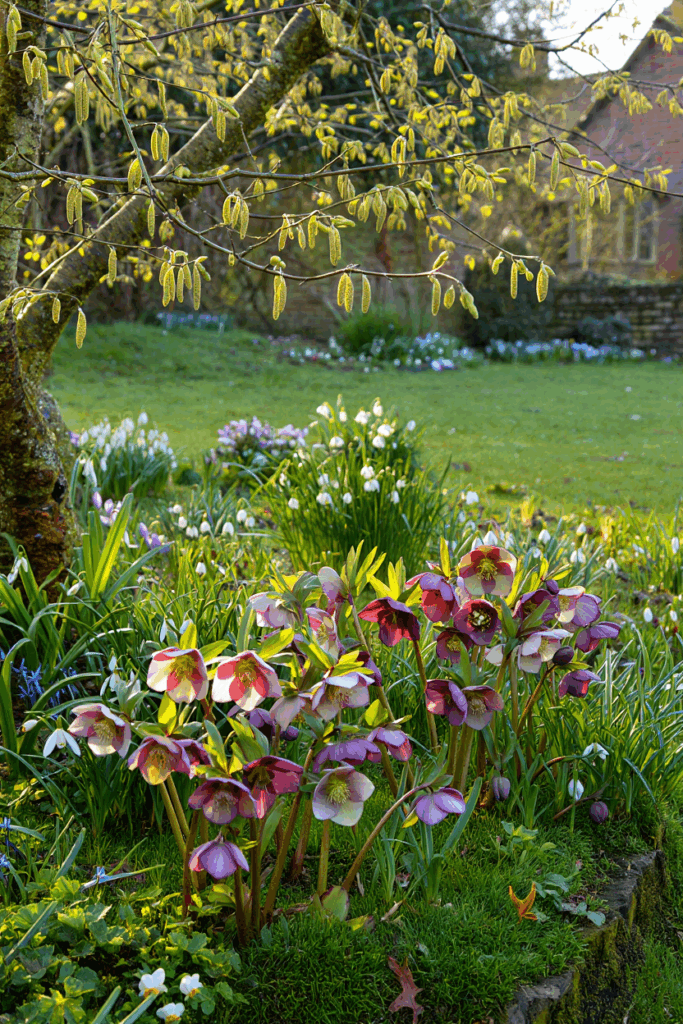
Every gardener who battles slugs should have at least one hellebore. The leaves are thick, leathery, and loaded with bitter alkaloids that make them completely unappealing to molluscs. Slugs may slime across anything else in your shade bed, but they’ll leave hellebores untouched. Even deer and rabbits tend to steer clear—proof that toughness doesn’t have to mean a lack of beauty.
And beautiful they are. Hellebores bloom when almost nothing else dares—late winter through early spring, sometimes pushing through frost and snow with bowed heads of cream, plum, green, or dusky rose. As the petals age, they deepen in tone, giving the flowers a painterly, antique look that lasts for weeks. Their evergreen foliage fills out again just as the garden begins to wake, giving structure when you need it most.
They thrive in partial to full shade, especially under deciduous trees where winter light filters through before the canopy closes. The hybrid Helleborus × hybridus is the classic choice, with countless color forms to suit every mood. For something moodier, try ‘Dark and Handsome’ or ‘Harvington Slate’; for soft, luminous tones, ‘Ivory Prince’ and ‘Pink Frost’ are favorites. All are hardy, long-lived, and, best of all, perfectly slug-proof.
- USDA Zones: 4–9 (depending on species)
- Light: Partial to full shade
- Soil: Moist, humus-rich, well-drained
- Bloom Time: Late winter to early spring
- Height/Spread: 12–18 in. tall, 18–24 in. wide
9: Japanese Anemone (Anemone × hybrida)
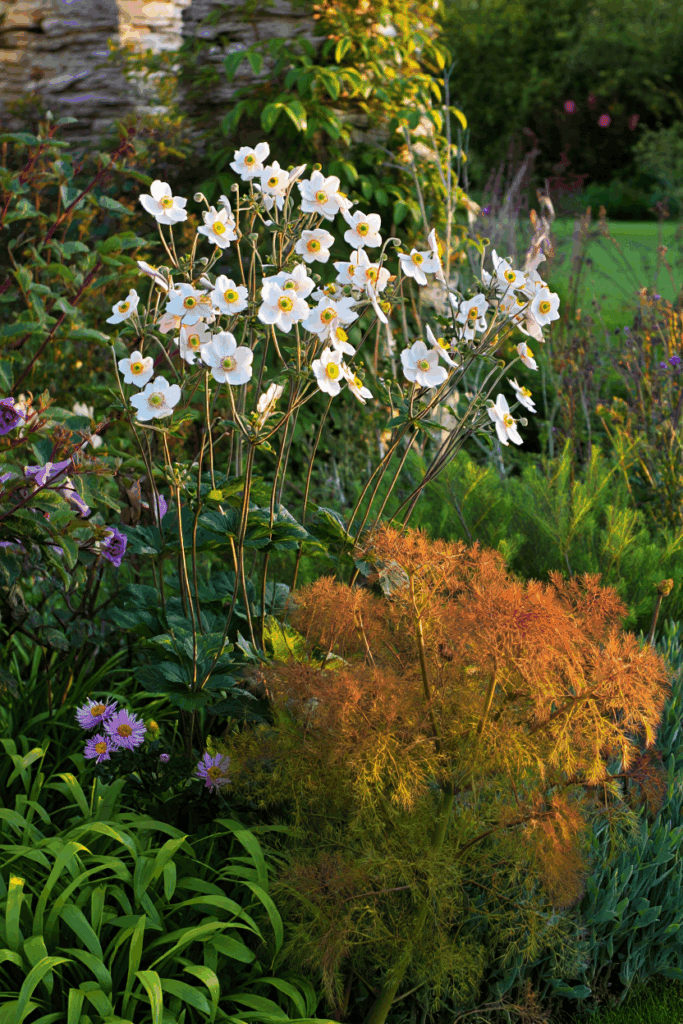
If you’ve ever wished for a plant that looks elegant but behaves like a survivor, Japanese anemones are exactly that. They bloom when most of the garden is fading, and somehow—despite their soft petals and tall stems—slugs completely ignore them. The leaves are just tough and bitter enough to be unappealing, and because most of the foliage sits higher up on wiry stems, it stays well out of reach of hungry molluscs lurking near the soil.
I love how these plants come alive in late summer, when the light turns golden and the air starts to cool. The flowers seem to float—simple, open, and weightless—just when the border needs something calm and graceful. Once you’ve planted them, they quietly spread into generous clumps that return every year without fuss. They can handle part shade, even spots under trees, as long as the soil stays a bit moist.
If you like a soft, classic look, go for ‘Honorine Jobert’—its white petals glow in evening light. For a romantic pink tone, ‘September Charm’ is lovely, and ‘Whirlwind’ brings a semi-double bloom that feels a little more special without being fussy. Whatever variety you choose, they’ll hold their own beautifully—and you’ll never have to worry about slugs turning them into lace.
- USDA Zones: 4–8
- Light: Partial shade or morning sun
- Soil: Moist, well-drained, rich in organic matter
- Bloom Time: Late summer to fall
- Height/Spread: 2–4 ft. tall, 18–36 in. wide
10: Siberian Bugloss (Brunnera macrophylla)
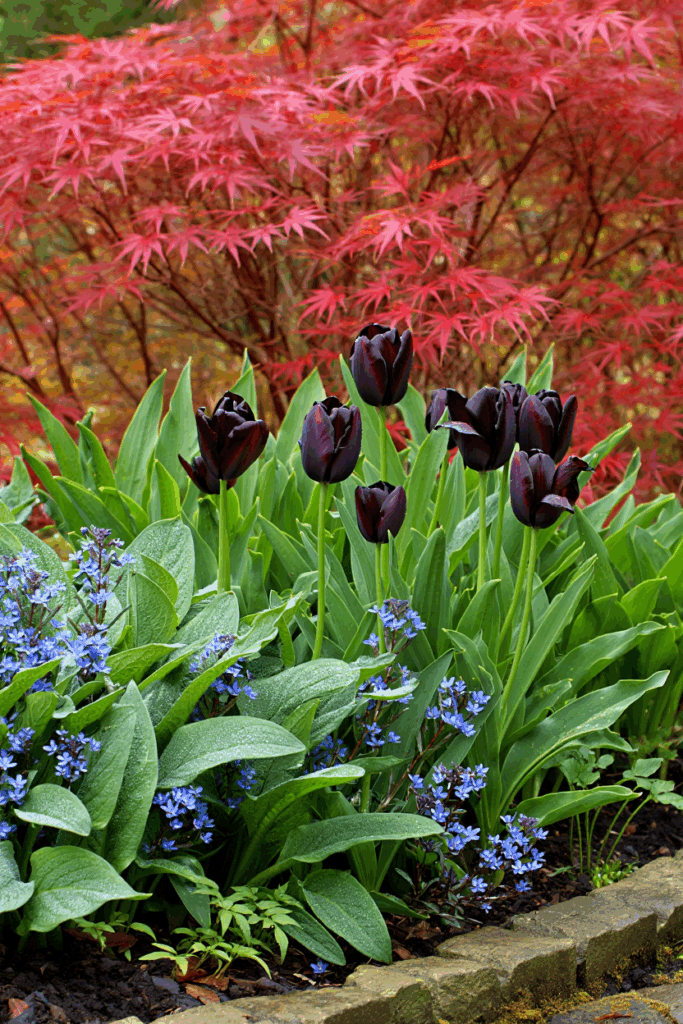
If you’ve ever planted hostas and come back the next morning to find nothing but holes, meet their tougher, prettier cousin—Siberian bugloss. It gives you those same broad, heart-shaped leaves but with a texture slugs can’t stand. The surface is slightly rough and fuzzy, almost sandpapery to a slug’s soft body, and the taste isn’t any better. Even in damp, shady spots where slugs usually thrive, Brunnera stays perfectly untouched.
In early spring, just when the garden still feels half asleep, sprays of tiny sky-blue flowers rise above the foliage like a mist of forget-me-nots. They’re simple, airy, and endlessly charming. Then the leaves take over—big, bold, and cool to the eye. Varieties like ‘Jack Frost’ shimmer silver with green veins; ‘Sea Heart’ has thicker, more slug-resistant leaves with a soft blue tint; and ‘Looking Glass’ practically glows in low light. They fit anywhere you’d use hostas but with none of the heartbreak.
Plant Brunnera in part to full shade with soil that stays evenly moist but never waterlogged. Once established, it’s almost carefree—coming back every year, expanding gently, and looking elegant through every season.
- USDA Zones: 3–8
- Light: Partial to full shade
- Soil: Moist, humus-rich, well-drained
- Bloom Time: Early to mid-spring
- Height/Spread: 12–18 in. tall, 18–24 in. wide

Written By
Amber Noyes
Amber Noyes was born and raised in a suburban California town, San Mateo. She holds a master’s degree in horticulture from the University of California as well as a BS in Biology from the University of San Francisco. With experience working on an organic farm, water conservation research, farmers’ markets, and plant nursery, she understands what makes plants thrive and how we can better understand the connection between microclimate and plant health. When she’s not on the land, Amber loves informing people of new ideas/things related to gardening, especially organic gardening, houseplants, and growing plants in a small space.
